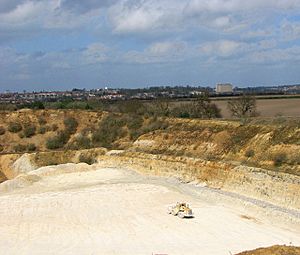Caistor St Edmund Chalk Pit facts for kids
| Site of Special Scientific Interest | |
 |
|
| Area of Search | Norfolk |
|---|---|
| Interest | Geological |
| Area | 23.6 hectares (58 acres) |
| Notification | 1985 |
| Location map | Magic Map |
The Caistor St Edmund Chalk Pit is a special place in Norfolk, south of Norwich. It's a large area, about 23.6 hectares (that's like 58 football fields!), and it's protected because of its amazing geology. This means it's a "Site of Special Scientific Interest" (SSSI) because it helps scientists learn about Earth's past.
Contents
Caistor St Edmund Chalk Pit: A Window to the Past
This chalk pit is like a giant history book made of rock! It shows us what the Earth was like about 75 million years ago during a time called the late Campanian period. Imagine dinosaurs still roamed the Earth then! The rocks here are called Beeston Chalk, and they are full of clues about ancient life.
What Makes This Place Special?
The chalk at this site was formed from the tiny shells and skeletons of sea creatures that lived in a warm, shallow sea millions of years ago. Over time, these tiny bits piled up and turned into the soft white rock we call chalk. This particular chalk pit is important because it gives us the best look at this specific type of chalk from the Campanian period in the area.
Discovering Ancient Life
Scientists love this chalk pit because it's packed with fossils! Fossils are the preserved remains or traces of ancient plants and animals. Here, you can find many fossils of molluscs, which are creatures like snails, clams, and squids, and sea urchins, which are spiky, round sea animals. These fossils help us understand what kind of life existed in the seas millions of years ago and how the environment has changed over time.
Can You Visit?
Even though this chalk pit is super interesting, it's on private land. This means it's not open to the public for visits. Places like this are often kept private to protect their delicate features and the important scientific information they hold. Scientists and researchers can sometimes get special permission to study the site, but for everyone else, it's best to learn about it from books and online resources.

